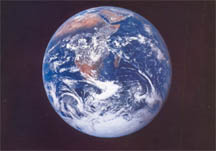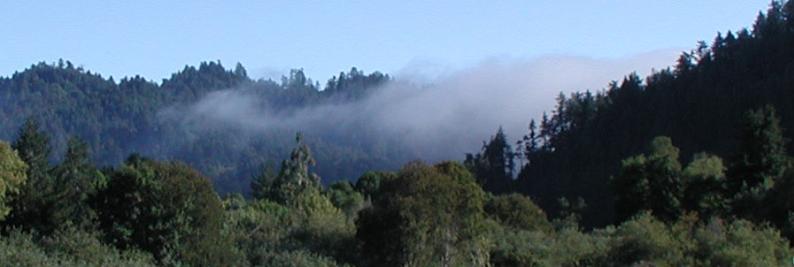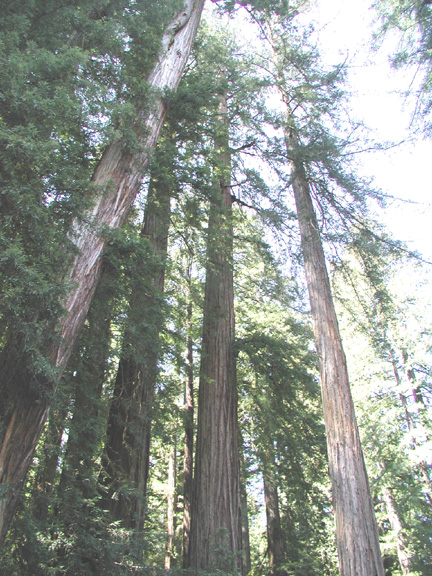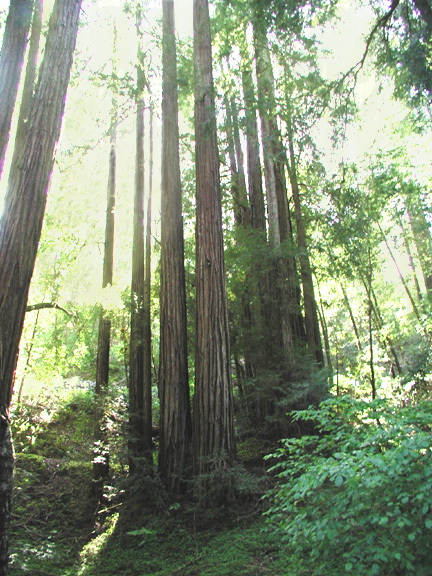
|
The Redwood Forest
First posted February 1, 2004
Last updated June 19, 2009
Cazadero Performing Arts Camp lies
nestled along Austin Creek, in a wonderful and rare
natural area. The dominant plant is the Coast Redwood,
Sequoia
sempervirens. This famous symbol of
California grows to a height of 200 to 240 feet (the
record for a Coast Redwood is 368 feet, taller than
either the Statue of Liberty or the Capitol Dome in
Washington, DC). The towering size of the Coast Redwood
casts a long shadow, both actually and figuratively.
Its shade promotes the growth of ferns and cools the
streams that flow underneath it. Its leaves and bark
contain a reddish toxin, tannic acid, that gives the
tree its name and deters other plants from growing.
Along with the climate and soil conditions, it defines
a plant and animal community called the Redwood
Forest. If you have not yet read the Introduction
to Biozones, you might want to now, as
it will help you understand the rest of this page.

Lets first look at the climate conditions
that make the beauty of Cazadero possible.
| Climate Conditions |
| |
|
 |
At the simplest level,
fog is caused by global weather
patterns and local hot air rising
in the Central Valley pulling in cool ocean air
laden with moisture. But the real story is much
more interesting.
The story begins with the weather
pattern out over the Pacific Ocean. The prevailing
winds of the North
Pacific High circle clockwise, owing to the
Earth's rotation. This effects both the air mass
and the ocean surface. As the moist, cool ocean
air merges with air masses over the California
land mass, it gives birth to a "ballet of
fantastic flowing forms of aerial moisture"
(SF Chronicle, June 12, 2000). |
| 
|
Look at the photograph of California at left,
taken from space. The clear skies are caused by
a high pressure area off the coast called the
North
Pacific High, which is a massive, semi-permanent
high-pressure system that occupies most of the
Pacific Ocean north of the equator. The photo
also shows California's 500-mile-long Central
Valley. The sun beats down on the Valley, heating
the air to temperatures of 100 degress and more.
This creates an onshore flow of cool, moist air.
On the right, air from out over the ocean north
of California has run into cold water upwelling
along the coast, which was caused by the Earth's
rotation moving the warm surface water offshore.
The combination of cool moist air and cold ocean
water has created fog. The waves in the air mass
are clearly seen. The mass flows along the coast
and into the low parts of the coastal mountains:
the river valley of the Russian River and the
Golden Gate. You may have seen the ballet of fog
as it flows over the Marin Headlands and crosses
the Golden Gate Bridge. If you looked closely,
you might have been able to see the waveforms
of the fog. You certainly can see if it you are
flying out of or into San Francisco Airport. (For
a more complete analysis of the complex forces
that cause our celebrated fog, see The
Fog is Clearing.) |
|

Fog rolling in from the ocean over the coast at Mt Tamalpais
State Park
Photo taken by David Nelson, July 31,
2004
The fog rolls many summer evenings and
persists to around noon. This keeps the temperature
down and the humidity up, creating the unique conditions
that allow us to have the only population of coast redwoods
in the world. In the distance, you can see the fog out
over the ocean. Moist, cool air is both drawn in by
the updrafts of warm air in the Central Valley as well
as pushed in by the North Pacific High (see above).
This combines with the upwelling of cold water along
the California coast, refrigerating the moist air and
condensing its moisture into fog.

Fog rolling in from the ocean along
the Russian River
Photo taken by David Nelson, July 23,
2004
This fog is coming in the Russian River
basin at 5 pm. The movement of the fog is a fascinating
study of the fluid nature of the atmosphere. We often
don't think of air as a fluid, a term we usually reserve
for liquids. The fog is a great demonstration of the
fluid nature of the air. You can see it flow in from
the sea, rounding over mountains and descending into
valleys and basins. It is easily seen when driving from Marin to San Francisco. As you pass the Marin Headlands and before you cross the Golden Gate Bridge, you can see the fog flowing over the Headlands and out into the bay. This cool flow of moist air is found all along the coast, from Monterey to southern Orgeon, and is essential
to the survival of our redwoods.

The Redwood Forest Biozone
Classically, the redwood forest biozone is divided
into three forms, and then
further subdivided into plant communities.
The three forms of redwood forest are the alluvial-flat
forest, the redwood/Douglas-fir forest,
and the redwood/mixed evergreen forest.
The main area of Camp Cazadero
is an example of the first type, the alluvial-flat
forest. It is characterized by deep soil that
has been deposited by the river over geologic
ages. This form of redwood forest provides the
ideal growing conditions for redwood trees, and
all of the groves of massive coast redwood grow
in alluvial-flats. Daily temperatures are mild
and seasonal changes are minimal, summer fogs
are persistent, soils are deep, well-drained,
and nutrient-rich, soil moisture is plentiful,
even at the end of California's Mediterranean
climate summer (characterized by no rain), and
fires are less common and generally of low intensity.
The best examples of the alluvial-flat redwood
forest are those along the Smith, Klamath, and
Eel rivers, but we also have some in the deeper
canyons along the San Lorenzo and Big Sur rivers.
It is not surprising that all of our famous coast
redwood parks are in these areas (see this website
for more information about parks: California
Recreation). Big Basin State Park,
the world's first redwood park (1901), is along
the San Lorenzo river.
Notice in the photograph at the right that there
are essentially no trees other than redwoods,
and that these are all rather tall, with little
in the way of understory. This is a classic alluvial-flat
redwood forest. |
 |
| |
Redwoods
at Cazadero near the Family Camp |
 |
This group of redwoods is located
near the Family Camp, just uphill from the upper
photograph. This shows the limited understory, with
just a few trees filling in the space from the treetops
of the redwoods to the ground. It also shows that
there are limited groundstory plants: some ferns
and shrubs. Although there is glaring sunlight at
the top of the forest, very little light reaches
the ground. A few sunbeams and sunflecks are all
that are available to supply the groundstory plants,
so they are few in number and have to be very efficient
in using sunlight. |
Redwoods
at Cazadero near the Family Camp |
|
There is a lot to enjoy and to learn about the Redwood Forest. Take a walk around camp and keep your eyes open!

Riparian
Biozone
Oak Woodland
Biozone
Chaparral Biozone
Grassland Biozone
Trees and
Capillary Action
The Age of Redwood
Trees
A poem to contemplate while admiring the redwoods:
Frost's
The Road Not Taken.
|

|

